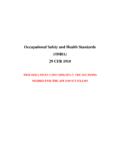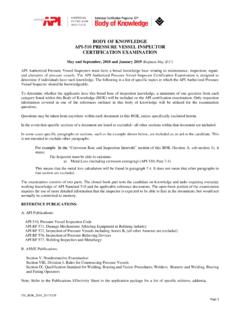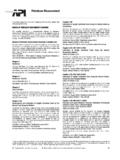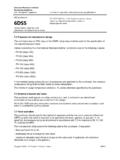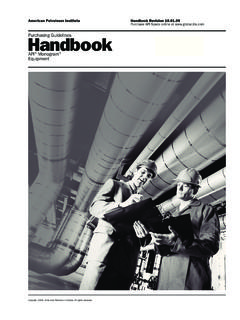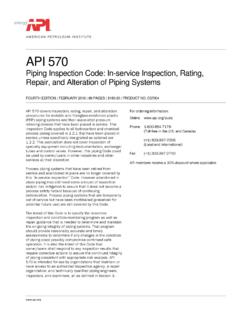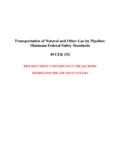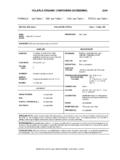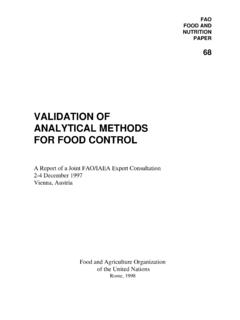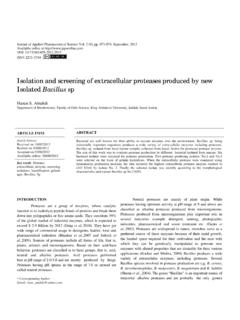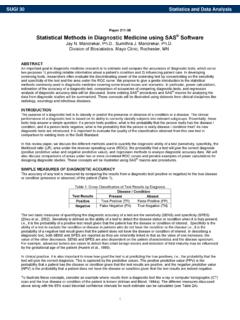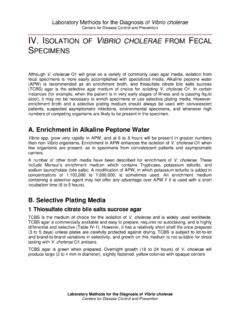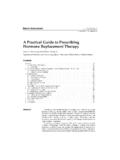Transcription of Frequently Asked Questions About TPH Analytical …
1 Frequently Asked Questions About TPH Analytical methods for Crude Oil Modified from API Publication 4709 September 2001. WHAT IS THE TRADITIONAL APPROACH FOR MANAGING. HYDROCARBON-IMPACTED SOILS AT E&P SITES? Traditionally, hydrocarbon-impacted soils at E&P sites have been managed based on their total petroleum hydrocarbon (TPH) content. Oil and gas industry guidance on TPH clean-up concentrations at E&P. sites was not based upon risk to human health; rather, it was based on Traditional approaches for the protection of plants and water resources [API, 1993; Currier and managing E&P sites were Peoples, 1954; Udo, et al.]
2 , 1975; Baker, 1970; deOng, et al., 1927;. based upon protection of plant and water resources. Plice, 1948; Chaineau, et al., 1997; and Saterbak, et al., 1999]. This work illustrated that 10,000 mg/kg TPH from crude oil did not adversely impact the growth of most plants nor pose a risk of leaching to groundwater. Some states adopted a TPH clean-up level of 10,000. mg/kg (1% by weight) based on these results. However, other states used TPH standards as low as 100 mg/kg in soil that are similar to those developed for gasoline leaks at underground storage tank sites for the protection of groundwater.
3 This standard might be applied to an E&P site even though a heavy crude oil, with no potential to leach to groundwater, may have been the only onsite petroleum hydrocarbon. Recent research initiatives have established a more consistent technical approach for the management of petroleum hydrocarbons that emphasizes the protection of human health and determined that a TPH. TPH measurements of several natural materials yield signifi- concentration of 10,000 mg/kg is indeed protective at E&P sites. cant TPH concentrations: WHAT IS TOTAL PETROLEUM HYDROCARBON OR TPH?
4 TPH is defined by the Analytical method that is used to measure it. Conventional TPH measurement techniques quantify only those hydrocarbons that are extracted by the particular method. To the extent Grass 14,000 mg/kg that the hydrocarbon extraction efficiency is not identical for each method, the same sample analyzed by different TPH methods will produce different TPH concentrations. Conventional bulk measurements of TPH in a sample are sufficient for Dried Oak Leaves screening the acceptability of site concentrations, based upon a compar- 18,000 mg/kg ison with existing TPH regulations.
5 However, these bulk measure- ments are not sufficient to support a human health risk assessment. To illustrate this point, high bulk TPH concentrations can be measured in items that clearly do not pose a risk to human health. For example, TPH concentrations have been measured in many items that can be Pine Needles 16,000 mg/kg found throughout nature including grass (14,000 mg/kg of TPH), pine needles (16,000 mg/kg of TPH), and oak leaves (18,000 mg/kg). It has also been measured in household petroleum jelly at concentrations of 749,000 mg/kg. Although these TPH concentrations are substantially Petroleum Jelly 749,000 mg/kg Frequently Asked Questions About TPH Analytical methods for Crude Oil greater than many existing TPH standards, none of these materials are considered a risk to human health.
6 WHAT methods ARE USED TO MEASURE BULK TPH IN SOIL AND. GROUNDWATER ? Analytical methods Some of the more common methods for the analysis of TPH include: (1) Method or Modified , (2) Method for oil and grease, (3) Modified 8015M for Diesel-Range Organics (DRO) and (4). Modified 8015M for Gasoline-Range Organics (GRO) [TPHCWG, 1998]. Method consists of solvent extraction followed by treatment in a silica gel column and infrared spectroscopy; the modified Method 8015 for DRO and GRO are solvent extractions followed by gas chromatography. If it is suspected that the sample is predominately a gasoline ( , volatile) fraction, purge and trap sample introduction to the gas chromatograph is often used in the determination of GRO.
7 Method is a gravimetric method that consists of solvent extraction, evaporation of the solvent, and a weight measurement. In addition to these "standard" methods , it should be recognized that there are many permutations of these analyses that have been developed and applied by the individual states. These permutations evolved because, historically, no one universal method for the measurement of petroleum hydrocarbons was available for use. Many of these methods are modified versions of the gas chromatographic methods and are referred to as "modified 8015".
8 In many instances, the regulatory body does not have these methods available in written form. Shortcomings Figure 1 shows the overlap between the carbon number ranges of different hydrocarbon products as well as the overlap in the corres- ponding TPH Analytical methods . For example, this figure demon- strates that a TPH method designed for gasoline range organics ( , C6. to C12) may report some of the hydrocarbons present in diesel fuel ( , C10 to C28). The same is also true for TPH Analytical tests for diesel range organics which will identify some of the hydrocarbons present in gasoline-contaminated soils.
9 Lastly, TPH Method covers the complete range from gasoline through lube oil, motor oil, and grease ( , C8 to C40). However, crude oil contains hydrocarbons with carbon numbers that range from C3 to C45+ and is not fully addressed even with the use of all three TPH methods . 2. Frequently Asked Questions About TPH Analytical methods for Crude Oil FIGURE 1. CARBON NUMBER RANGES ADDRESSED BY TPH Analytical methods . Gasoline Diesel Fuel/Middle Distillates Lube/Motor Oil, Grease C2 C4 C6 C8 C10 C12 C14 C16 C18 C20 C22 C24 C26 C28 C30. TPH methods : Approximate Carbon Ranges Purgeable/Volatile/Gasoline Range, Modified 8015, Purge and Trap, GC.
10 Diesel Range, Modified 8015, Extraction, GC. , Modified : Extraction, IR. WHAT IS THE ROLE OF BULK TPH MEASUREMENTS IN E&P SITE. MANAGEMENT? An understanding of chemical composition of hydrocarbons is The hazard evaluation that is conducted as part of the risk evaluation of required for risk-based manage- a site requires some level of understanding of the chemical composition ment of TPH. of the hydrocarbons that are present in the soil and groundwater. The traditional TPH measurement techniques are not adequate to support this hazard evaluation because they provide no specific information About the hydrocarbons that are detected.
